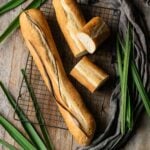Homemade Cuban Bread (Pan Cubano)
Homemade Cuban bread, or pan Cubano, is perfect for Cuban sandwiches, toast, or enjoying plain with butter. This recipe shows you how to make this crusty white bread so you don’t have to go to Miami or Cuba to get the authentic loaf!
Servings: 8
Calories: 234kcal
Ingredients
- 4 cups bread flour sifted
- ¼ cup lard melted
- 1 ¼ cups room-temperature water
- 2 ¼ teaspoons fast-action yeast
- 2 teaspoons granulated sugar
- 2 teaspoons salt
Instructions
Making the Dough
- Weigh the bread flour using a kitchen scale, then sift it into a bowl and set aside. Melt the lard in the microwave or in a small saucepan.
- Stir together the water, yeast, and sugar in a mixing bowl until blended.
- Add the melted lard and half of the flour to the mixture. Mix until a wet paste has formed, then add in the salt and enough flour to make a somewhat sticky dough. Please remember that the humidity and brand of flour will affect how much flour you add.
- Knead the dough on a floured surface for 10-15 minutes until the dough is smooth, no longer sticky, and passes the windowpane test. Test the dough by breaking off a lump of dough and stretching it between the thumb and forefinger of each hand to create a windowpane. The dough should stretch until it’s translucent in places without breaking. If it does, this means the dough has been sufficiently kneaded. If not, continue kneading for a minute longer and test again.
- Shape the dough into a ball, place in a bowl, and cover tightly with plastic wrap. Let the dough prove until at least doubled in size, about 1 to 1 ½ hours.
- While the dough is proving, prepare the palmetto fronds. Cut two fronds, then split them in half lengthwise. Sanitize them with soap and hot water, then dry them. (If you don't have access to palmetto fronds, use a piece of baker's twine, or simply score the loaf with a lame before baking.)
Shaping
- Line two 11x17-inch cookie sheets with parchment paper.
- Dump the dough onto a floured surface and punch it down all over to knock out air pockets. Cut it into two pieces, then shape each piece into a rectangle and roll it up tightly from one of the long sides. Pinch the seam and ends to seal, then roll it gently with the palms of your hands to extend its length to about 18 inches.
- Press the palmetto fronds (or string) into the top of the loaves, overlapping them slightly, then flip the loaf over so the fronds are on the bottom. Cover the bread with plastic wrap and let it prove for 45 minutes to 1 hour, until the loaves have almost doubled in size and the dough springs back quickly when lightly prodded with a fingertip.
- Preheat the oven to 425°F and put a metal casserole dish on the lowest shelf of the oven to preheat.
Baking
- Once the loaves are fully proved, gently flip then over so the palmetto fronds are on top. If they deflate a little, that's okay; they will rise in the oven.
- Slide the trays into the oven, pour a cup or two of water into the hot metal dish, and quickly shut the oven door.
- Bake for 25-30 minutes, or until the loaves are golden brown, crusty, and have an internal temperature of 200°F on a meat thermometer. Remove the pan of water during the last 5 minutes.
- Let the loaves cool for 45 minutes to 1 hour on a wire rack before slicing and serving. This allows the bread to finish cooking all the way through.
Notes
- Weigh the ingredients when baking for much more accurate measurements.
- Note about Flour: This recipe was developed using King Arthur bread flour. Please weigh it using a kitchen scale to get an accurate measurement. Remember that the brand of flour and humidity will affect the exact amount you need for the dough.
- Sanitize the palmetto fronds before using. I like to wash them with dish soap and rinse in hot water, then dry them.
- Place the dough in a cold oven with a pan of boiling water on the shelf beneath. The humid steam creates a warm, cozy environment for the yeast to work, creating a faster rise.
Nutrition
Serving: 1serving | Calories: 234kcal | Carbohydrates: 47g | Protein: 8g | Fat: 1g | Saturated Fat: 0.2g | Polyunsaturated Fat: 0.5g | Monounsaturated Fat: 0.1g | Sodium: 594mg | Potassium: 77mg | Fiber: 2g | Sugar: 1g | Vitamin A: 58IU | Vitamin C: 0.4mg | Calcium: 14mg | Iron: 1mg
